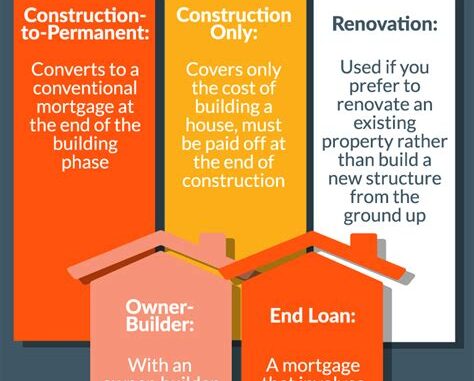
When it comes to embarking on your construction journey, securing the right financing is paramount. Understanding the landscape of construction loan rates can make a significant difference in your project’s overall cost and success. With numerous lenders vying for your attention, it’s crucial to compare rates effectively to find the best fit for your unique needs.
This article delves into the key factors influencing construction loan rates, provides insights into how various lenders stack up against each other, and outlines vital terms that will empower you in your decision-making process. Additionally, we’ll share expert tips for securing lower rates that can help your project thrive. Whether you’re a seasoned builder or a first-time homeowner, this guide aims to illuminate the path to selecting the most suitable construction loan for your venture.
Understanding Construction Loan Rates: Key Factors That Influence Costs
When it comes to comparing construction loan rates, it’s crucial to understand the various factors that influence the costs associated with these loans. These rates can vary significantly between different lenders and are impacted by multiple elements:
- Credit Score: A higher credit score often translates to lower interest rates. Lenders assess your creditworthiness to determine the risk involved in lending to you.
- Loan Amount: The total amount you wish to borrow can impact your rate. Larger loans may sometimes attract higher rates due to increased risk for the lender.
- Down Payment: The size of your down payment can also impact your loan rate. A substantial down payment may decrease your interest rate, as it reduces the lender’s risk.
- Type of Construction: The nature of the construction project, whether it’s a new build or a renovation, can influence loan rates. Residential projects often have different rates compared to commercial projects.
- Term Length: The duration of the loan can play a role in cost. Shorter-term loans usually have lower rates, but they come with higher monthly payments.
- Market Conditions: Economic factors like inflation, the Federal Reserve’s interest rate changes, and overall demand for loans can affect prevailing construction loan rates.
- Loan Types: Different types of construction loans, such as fixed-rate or variable-rate loans, may lead to different interest rates. Each type carries its own risks and benefits.
By considering these factors, borrowers can make well-informed comparisons of construction loan rates across different lenders and ultimately choose the option that best aligns with their financial goals.
Comparing Construction Loan Rates: How Different Lenders Stack Up
When you’re comparing construction loan rates, it’s essential to evaluate various lenders in order to find the most favorable terms for your specific project. Different lenders may offer varying interest rates, fees, and loan conditions that can significantly impact your overall construction costs. Here’s a breakdown of key factors to consider while comparing lenders:
- Interest Rates: Start by comparing the interest rates offered by different lenders. A lower rate can lead to substantial savings over the life of the loan.
- Loan Type: Determine whether the lender provides fixed or variable interest rates and their specific loan terms. Fixed rates offer stability, while variable rates may be lower initially but can fluctuate.
- Fees and Closing Costs: Don’t forget to examine the fine print regarding fees associated with the loan. These can include origination fees, appraisal fees, and closing costs, all of which can add to your total expenses.
- Loan-to-Value Ratio (LTV): Check the LTV ratio that each lender is willing to extend. A higher LTV means less cash required upfront but can also mean higher risk for the lender.
- Approval Process: Some lenders may have a more streamlined approval process than others. Evaluate how long each lender takes to process applications and approve loans.
- Reputation and Customer Service: Finally, consider the lender’s reputation and quality of customer service. A lender with good customer service can make the process smoother and provide valuable guidance throughout your construction journey.
comparing construction loan rates from different lenders involves evaluating interest rates, fees, loan terms, and overall lender reliability. This comprehensive approach will help you make an informed decision and secure the best financing for your construction project.
Important Terms to Know When Comparing Construction Loans
When comparing construction loans, it’s crucial to familiarize yourself with specific terminology that can affect your understanding and decision-making process. Here are some key terms that you should know:

- Draw Schedule: This refers to the predetermined timeline for disbursing funds during your construction project. Lenders typically release money in stages based on the completion of certain milestones.
- Interest Reserve: This is a fund set aside to cover the construction loan’s interest payments, often used in the early stages of the project when cash flow might be tight.
- Loan-to-Value Ratio (LTV): The LTV ratio compares the loan amount to the appraised value of the property, helping lenders assess risk. A lower LTV often results in better rates.
- Fixed vs. Variable Rate: Fixed rates remain constant throughout the loan term, whereas variable rates can fluctuate based on market conditions, affecting your monthly payments.
- Prepayment Penalty: This is a fee charged by some lenders if you pay off your loan early, which can impact your savings if plan to refinance or pay off your loan sooner than expected.
- Contingency Reserve: A safety net set aside to cover unforeseen expenses during construction, ensuring that your project remains financially viable even when unexpected costs arise.
Being well-versed in these terms will empower you when comparing construction loans, allowing for more informed discussions with lenders and ultimately leading to better finance terms for your project.
Evaluating Interest Rates: Finding the Best Loan for Your Project
When it comes to comparing construction loan rates, evaluating interest rates is crucial to securing the best financial plan for your project. Interest rates can vary significantly among lenders, and understanding these variations is essential for making an informed decision.
First, consider the type of interest rate offered by the lender. Fixed interest rates remain constant throughout the loan term, providing stability in monthly payments. Conversely, variable or adjustable rates can fluctuate, potentially increasing your payment over time. Weigh the risks and benefits of each option based on your financial situation and project timeline.
Next, look at the annual percentage rate (APR) rather than just the interest rate. The APR gives a holistic view of the cost of borrowing, including points, fees, and other charges associated with the loan. This broader perspective allows you to make a more accurate comparison when comparing construction loans from different lenders.
Moreover, it’s vital to understand how your credit score plays a role in the interest rates offered to you. Lenders typically provide better rates to borrowers with higher credit scores, as they are perceived as lower risk. Prior to applying for a loan, check your credit report and take steps to boost your score if necessary—this could save you a substantial amount in interest payments.
Don’t hesitate to seek out personalized rate quotes from multiple lenders. Many institutions provide free online tools and calculators that can help simulate potential loan costs based on your project specifics. Utilize these resources to ensure that you’re not only comparing construction rates but also getting a tailor-fit loan that suits your unique needs.

Tips for Securing Lower Construction Loan Rates from Lenders
When it comes to comparing construction loan rates, knowing how to secure the lowest possible rates can make a significant difference in the overall cost of your project. Here are some effective strategies you can implement:
- Improve Your Credit Score: Lenders are more likely to offer lower rates to borrowers with high credit scores. Check your credit report for errors, pay down outstanding debts, and make payments on time.
- Shop Around: Don’t settle on the first loan offer. Comparing different lenders can help you find the most competitive rates.
- Consider Fixed-Rate Loans: Fixed-rate construction loans often come with lower rates compared to variable-rate loans which can fluctuate over time.
- Increase Your Down Payment: Providing a larger down payment can reduce the lender’s risk and possibly lead to lower interest rates.
- Lock in Your Rate: If rates are currently low, consider locking in your rate with your lender to protect yourself against potential increases.
- Build a Strong Relationship with Your Lender: Establishing a good rapport can lead to better terms, including lower rates. Regular communication and transparency about your financial situation can help in negotiations.
- Use a Mortgage Broker: A broker can provide access to multiple lenders and exclusive deals, helping you to find lower rates.
- Negotiate Fees: Some fees associated with construction loans can be negotiated, which could effectively lower your overall costs.
Following these tips can lead to more favorable loan terms and lower construction loan rates, ultimately saving you money as you undertake your building project. Always remember to conduct thorough research and actively compare construction loan offers before making your final decision.

Frequently Asked Questions
What is a construction loan?
A construction loan is a short-term, temporary loan used to finance the building of a new home or other real estate projects. It typically covers the cost of the land, materials, and labor needed to complete the construction.
How are construction loan rates determined?
Construction loan rates are determined by various factors including the lender’s internal policies, market interest rates, the borrower’s creditworthiness, the total loan amount, and the location and type of the project.
What types of construction loans are available?
There are generally three types of construction loans: construction-to-permanent loans, stand-alone construction loans, and renovation loans. Each has its unique features and repayment options that cater to different needs.
Why is it important to compare construction loan rates?
Comparing construction loan rates is important because even a small difference in rates can lead to significant savings over the life of the loan. It also helps borrowers find terms that best fit their financial situations and project timelines.
What factors should I consider when choosing a lender for a construction loan?
When choosing a lender, consider interest rates, fees, the lender’s reputation, closing times, customer service, and the flexibility of the loan terms. It’s also beneficial to ask about their experience with similar projects.
Are there additional costs associated with construction loans?
Yes, additional costs may include appraisal fees, inspection fees, origination fees, and potential penalties for late payments. It’s essential to review all costs upfront to avoid surprises during the construction process.
How can I improve my chances of getting a favorable construction loan rate?
To improve your chances, maintain a good credit score, provide a substantial down payment, and present a detailed and realistic construction plan. Also, having a strong financial background and stable income can positively influence the lender’s decision.

Leave a Reply